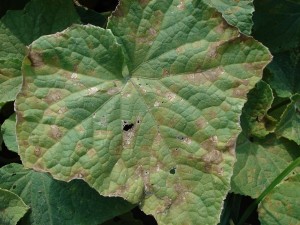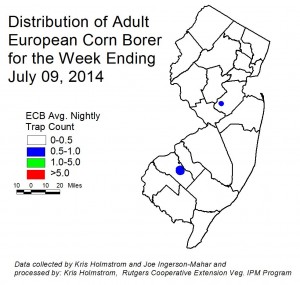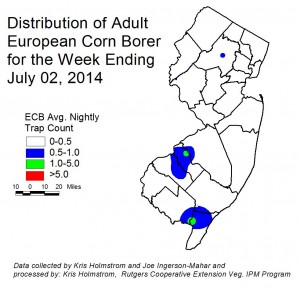Vegetable IPM Report 7-9-14 – Click to View | Download | Print
Maps for the Week
–European Corn Borer Map
–Corn Earworm Moth Blacklight Trap Map
–Corn Earworm Moth Pheromone Trap MapTopics for the Week
- Sweet Corn
- Peppers
- Pepper Weevil Report
- Tomatoes
- BMSB
- Pumpkins and Winter Squash
Vegetable Crops Edition
Seasonal updates and alerts on insects, diseases, and weeds impacting vegetable crops. New Jersey Commercial Vegetable Production Recommendations updates between annual publication issues are included.
Subscriptions are available via EMAIL and RSS.
Quick Links:
 NJ Commercial Vegetable Production Recommendations
NJ Commercial Vegetable Production Recommendations
 Rutgers Weather Forecasting - Meteorological Information important to commercial agriculture.
Rutgers Weather Forecasting - Meteorological Information important to commercial agriculture.
Veg IPM Update: Week Ending 7/9/14
Farm Food Safety: Irrigation Water Sampling
Testing irrigation water for generic E. coli is something that every farm should do. Timing and frequency of this testing varies depending on your water source. Here is a cheat sheet: [Read more…]
Controlling Cucurbit Downy Mildew
Once cucurbit downy mildew (CDM) is detected in the mid-Atlantic region (as of yesterday in Maryland) all cucurbit growers in New Jersey should begin to include downy mildew specific fungicides in their weekly fungicide programs on all cucurbit crops.

Symptoms of cucurbit downy mildew on infected cucumber leaf.
Veg IPM Update: Week Ending 7/2/14
Vegetable IPM Report 7-2-14 – Click to View | Download | Print
Maps for the Week
–European Corn Borer Map
–Corn Earworm Moth Pheromone Trap MapTopics for the Week
- Sweet Corn
- Peppers
- Pepper Weevil Report
- Tomatoes
- BMSB
- Pumpkins and Winter Squash
Cucurbit Downy Mildew Confirmed in Maryland 7-2-14
Cucurbit downy mildew has been confirmed on cucumber in Caroline County, Maryland.
This is the first report of cucurbit downy mildew in the mid-Atlantic region this growing season. All cucurbit growers should scout their fields on a regular, if not, daily basis. All cucurbit growers should consider switching to a preventative fungicide program that includes downy mildew specific fungicides. For more information, please see the 2014 Commercial Vegetable Fungicide Recommendations Guide.
Audit Ready:
Who Can Accompany You During A Third Party Audit?
Recently, a number of growers have asked:
“Who can accompany me during a third party food safety audit?”
Perhaps you had someone write your farm food safety plan for you or, you have a food safety consultant and you would like them to participate in or attend the audit.
 The USDA weighed in on this question and stated:
The USDA weighed in on this question and stated:
” There are no written requirements restricting the number of individuals on an audit. We allow the auditor to make that decision as far as how many people they wish to accompany them. A consultant can accompany the auditor and act as an observer but may not act as a participant in the audit.”
If you would like someone to accompany with you during the audit be sure to ask the inspector where they stand on who may attend the audit with you.


